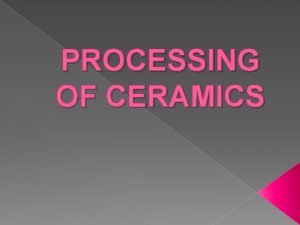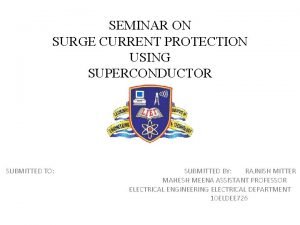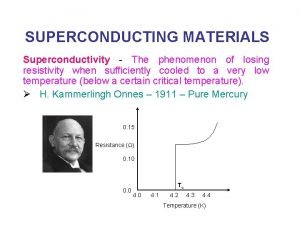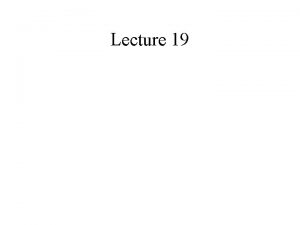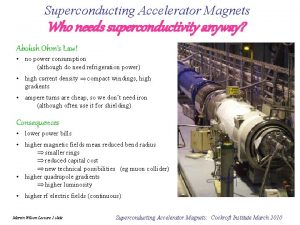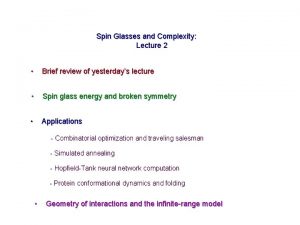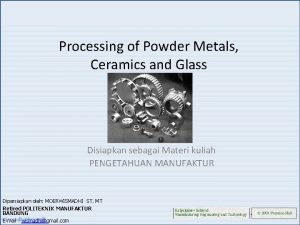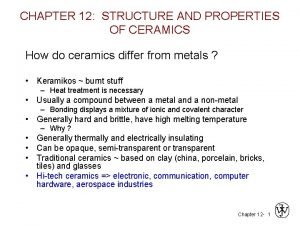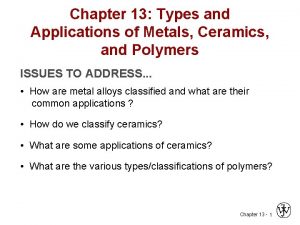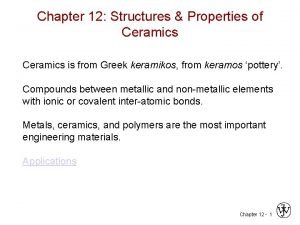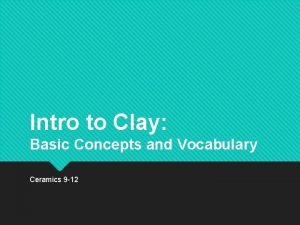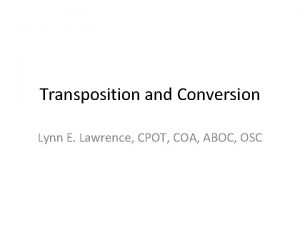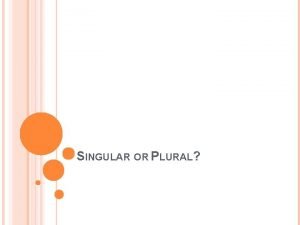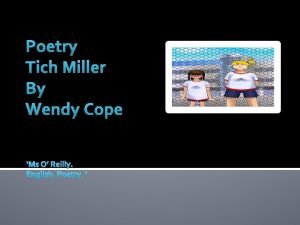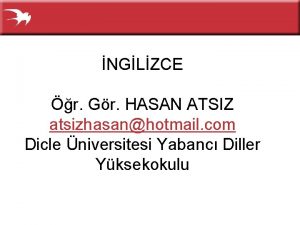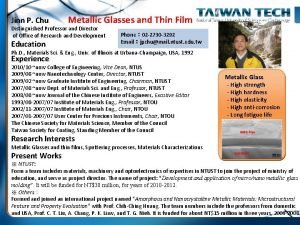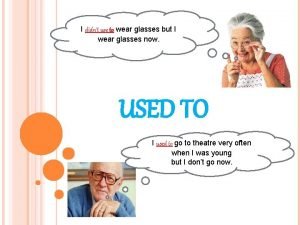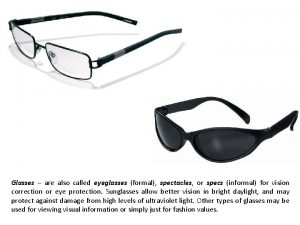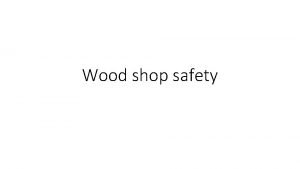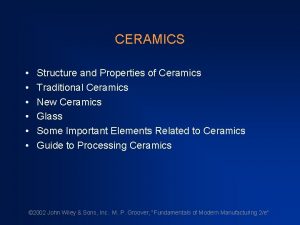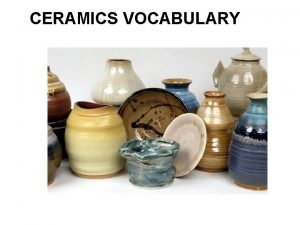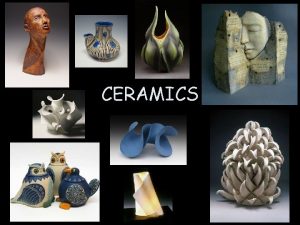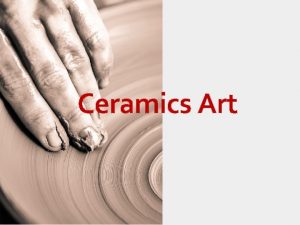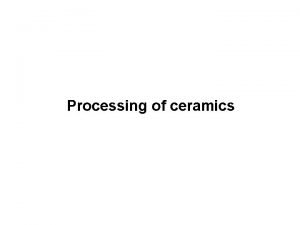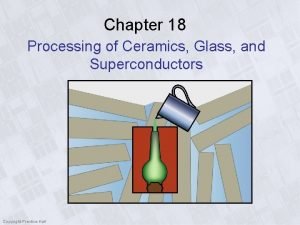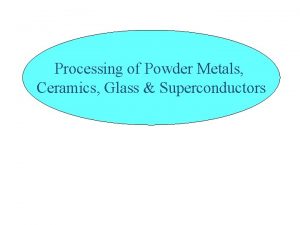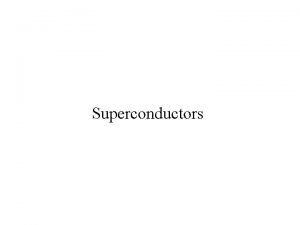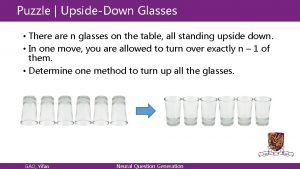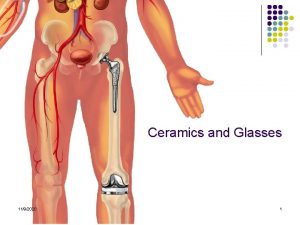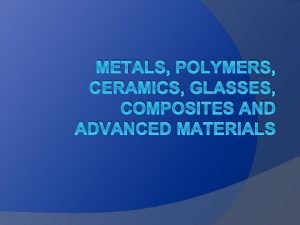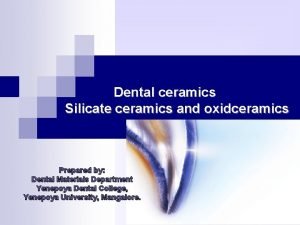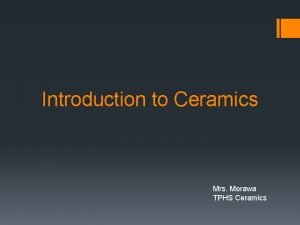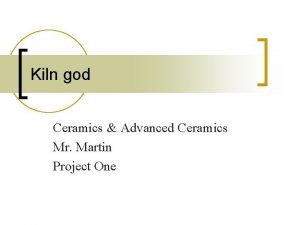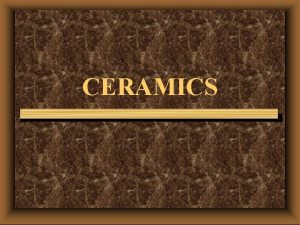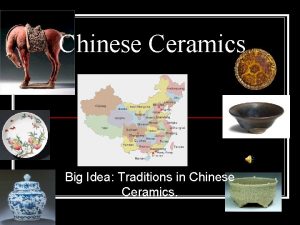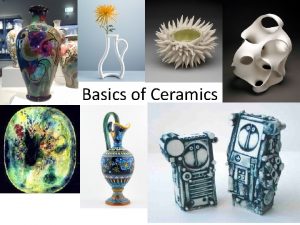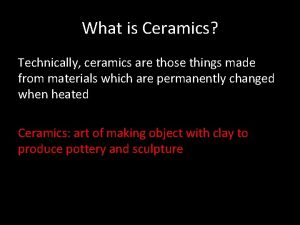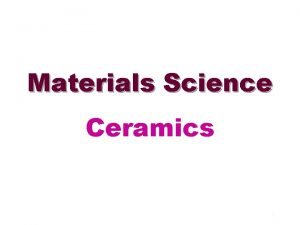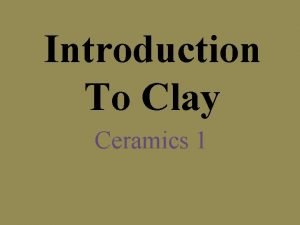Chapter 18 Ceramics Glasses Superconductors Processing and Equipment


























- Slides: 26

Chapter 18 Ceramics, Glasses, & Superconductors: Processing and Equipment Manufacturing Engineering and Technology , Seventh Edition Serope Kalpakjian | Steven R. Schmid Copyright © 2014 by Pearson Education, Inc. All rights reserved.

CHARACTERISTICS OF CERAMICS AND GLASS 1. HIGH TEMPERATURE STRENGTH 2. HIGH HARDNESS 3. LOW ELECTRICAL CONDUCTIVITY 4. LOW THERMAL CONDUCTIVITY 5. RESISTANCE TO WEAR 6. RESISTANCE TO CORROSION Manufacturing Engineering and Technology , Seventh Edition Serope Kalpakjian | Steven R. Schmid Copyright © 2014 by Pearson Education, Inc. All rights reserved.

PROCESSING METHODS FOR CERAMICS 1. Crushing materials the raw 2. Shaping 3. Drying 4. Finishing Manufacturing Engineering and Technology , Seventh Edition Serope Kalpakjian | Steven R. Schmid Copyright © 2014 by Pearson Education, Inc. All rights reserved.

PROCESSING METHODS FOR GLASSES 1. Mixing and melting the raw materials in a furnace 2. Shaping into molds Manufacturing Engineering and Technology , Seventh Edition Serope Kalpakjian | Steven R. Schmid Copyright © 2014 by Pearson Education, Inc. All rights reserved.

FIGURE 18. 1 Examples of (a) glass parts and (b) ceramic parts. Source: (a) Courtesy of Commercial Optical Manufacturing, Inc. (b) Courtesy of Kyocera. Manufacturing Engineering and Technology , Seventh Edition Serope Kalpakjian | Steven R. Schmid Copyright © 2014 by Pearson Education, Inc. All rights reserved.

SHAPING OF CERAMICS Manufacturing Engineering and Technology , Seventh Edition Serope Kalpakjian | Steven R. Schmid Copyright © 2014 by Pearson Education, Inc. All rights reserved.

TABLE 18. 1 General Characteristics of Ceramics Processing Manufacturing Engineering and Technology , Seventh Edition Serope Kalpakjian | Steven R. Schmid Copyright © 2014 by Pearson Education, Inc. All rights reserved.

FIGURE 18. 2 Processing steps involved in making ceramic parts. Manufacturing Engineering and Technology , Seventh Edition Serope Kalpakjian | Steven R. Schmid Copyright © 2014 by Pearson Education, Inc. All rights reserved.

ADDITIVES 1. Binder 2. Lubricant to reduce friction between particles 3. Wetting agent to improve mixing 4. Plasticizer to make the mix more plastic and easy to shape 5. Agents to control foaming Manufacturing Engineering and Technology , Seventh Edition Serope Kalpakjian | Steven R. Schmid Copyright © 2014 by Pearson Education, Inc. All rights reserved.

SHAPING PROCESSES FOR CERAMICS 1. Casting 2. Plastic forming 3. Pressing Manufacturing Engineering and Technology , Seventh Edition Serope Kalpakjian | Steven R. Schmid Copyright © 2014 by Pearson Education, Inc. All rights reserved.

FIGURE 18. 3 Sequence of operations in slip casting a ceramic part. (a) Mold is assembled and plug attached; some plugs incorporate draining features; (b) slurry, mixed from ceramic particles, binder, and water, is poured into the mold; (c) the mold is inverted and the slurry is poured from the mold, leaving a thin coating over the mold cavity; (d) after an initial drying period, the slip is removed from the mold, and features such as parting lines and sprue lips are removed; and (e) the slip is ready to be dried and fired in an oven, to develop strength and hardness. Manufacturing Engineering and Technology , Seventh Edition Serope Kalpakjian | Steven R. Schmid Copyright © 2014 by Pearson Education, Inc. All rights reserved.

FIGURE 18. 4 Production of ceramic sheets through the doctor-blade process. Manufacturing Engineering and Technology , Seventh Edition Serope Kalpakjian | Steven R. Schmid Copyright © 2014 by Pearson Education, Inc. All rights reserved.

FINISHING OPERATIONS 1. Grinding 2. Lapping and honing 3. Ultrasonic machining 4. Drilling 5. Laser beam machining Manufacturing Engineering and Technology , Seventh Edition Serope Kalpakjian | Steven R. Schmid Copyright © 2014 by Pearson Education, Inc. All rights reserved.

PRODUCTS 1. Flat sheets 2. Rods and tubes 3. Discrete products: bottles vases and eye glasses 4. Glass fibers Manufacturing Engineering and Technology , Seventh Edition Serope Kalpakjian | Steven R. Schmid Copyright © 2014 by Pearson Education, Inc. All rights reserved.

FORMING AND SHAPING OF GLASS Manufacturing Engineering and Technology , Seventh Edition Serope Kalpakjian | Steven R. Schmid Copyright © 2014 by Pearson Education, Inc. All rights reserved.

FLAT SHEETS 1. Float method 2. Drawing process Manufacturing Engineering and Technology , Seventh Edition Serope Kalpakjian | Steven R. Schmid Copyright © 2014 by Pearson Education, Inc. All rights reserved.

FIGURE 18. 7 The float method of forming sheet glass. Manufacturing Engineering and Technology , Seventh Edition Serope Kalpakjian | Steven R. Schmid Copyright © 2014 by Pearson Education, Inc. All rights reserved.

Drawing process FIGURE 18. 8 (a) Source: After W. D. Kingery. for drawing sheet glass from a molten bath. (b) Rolling process. Manufacturing Engineering and Technology , Seventh Edition Serope Kalpakjian | Steven R. Schmid Copyright © 2014 by Pearson Education, Inc. All rights reserved.

TUBING AND RODS Manufacturing Engineering and Technology , Seventh Edition Serope Kalpakjian | Steven R. Schmid Copyright © 2014 by Pearson Education, Inc. All rights reserved.

FIGURE 18. 9 Manufacturing process for glass tubing; air is blown through the mandrel to keep the tube from collapsing; glass tubes for fluorescent bulbs are made by this method. Manufacturing Engineering and Technology , Seventh Edition Serope Kalpakjian | Steven R. Schmid Copyright © 2014 by Pearson Education, Inc. All rights reserved.

FIGURE 18. 13 Centrifugal casting of glass; large telescope lenses and television-tube funnels are made by this process. Source: Based on data from Corning Glass Works. Manufacturing Engineering and Technology , Seventh Edition Serope Kalpakjian | Steven R. Schmid Copyright © 2014 by Pearson Education, Inc. All rights reserved.

GLASS FIBERS Continuous glass fibers are drawn through multiple orifices Manufacturing Engineering and Technology , Seventh Edition Serope Kalpakjian | Steven R. Schmid Copyright © 2014 by Pearson Education, Inc. All rights reserved.

TECHNIQUES FOR STRENGTHENING AND ANNEALING GLASS THERMAL TEMPERING the surfaces of hot glass are cooled rapidly by a blast of air residual compressive stresses develop at the surface interior part develosp tensile residual stresses Due to the high amount of energy stored in residual stresses, tempered glass shatters into numerous pieces when broken Manufacturing Engineering and Technology , Seventh Edition Serope Kalpakjian | Steven R. Schmid Copyright © 2014 by Pearson Education, Inc. All rights reserved.

FIGURE 18. 14 (a) The stages involved in inducing compressive surface residual stresses for improved strength. (b) Residual stresses in a tempered glass plate. Source: Courtesy of Corning Glass Works. Manufacturing Engineering and Technology , Seventh Edition Serope Kalpakjian | Steven R. Schmid Copyright © 2014 by Pearson Education, Inc. All rights reserved.

FIGURE 18. 15 Schematic illustration of the powder-in-tube process. Manufacturing Engineering and Technology , Seventh Edition Serope Kalpakjian | Steven R. Schmid Copyright © 2014 by Pearson Education, Inc. All rights reserved.

LAMINATED GLASS Consists of two pieces of flat glass with a thin sheet of tough plastic in between When it cracks the pieces are held together by the plastic sheet (less hazardous than tempered glass) Manufacturing Engineering and Technology , Seventh Edition Serope Kalpakjian | Steven R. Schmid Copyright © 2014 by Pearson Education, Inc. All rights reserved.
 Processing of ceramics
Processing of ceramics Surge current protection using superconductors wikipedia
Surge current protection using superconductors wikipedia Types of superconductors
Types of superconductors Types of superconductors
Types of superconductors Surge current protection using superconductors
Surge current protection using superconductors Superconductivity definition
Superconductivity definition Superconductors
Superconductors Spin glasses and complexity
Spin glasses and complexity Neighborhood processing in image processing
Neighborhood processing in image processing Examples of secondary processing
Examples of secondary processing Batch processing and interactive processing
Batch processing and interactive processing Powder metallurgy and metal ceramics
Powder metallurgy and metal ceramics Impurities in ceramics
Impurities in ceramics Die blanks ceramics
Die blanks ceramics Structure of ceramics
Structure of ceramics Wire clay cutter ceramics definition
Wire clay cutter ceramics definition Transposition glasses prescription
Transposition glasses prescription Plural panda
Plural panda Some singular or plural
Some singular or plural Aphakic glasses disadvantages
Aphakic glasses disadvantages Aphakic glasses disadvantages
Aphakic glasses disadvantages Tich miller poem
Tich miller poem Thief çoğul hali
Thief çoğul hali Jinn glasses
Jinn glasses I used to wear glasses
I used to wear glasses Formal spectacles
Formal spectacles Woodshop safety glasses
Woodshop safety glasses
